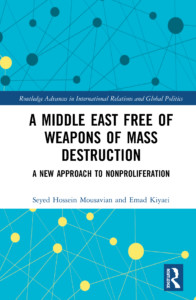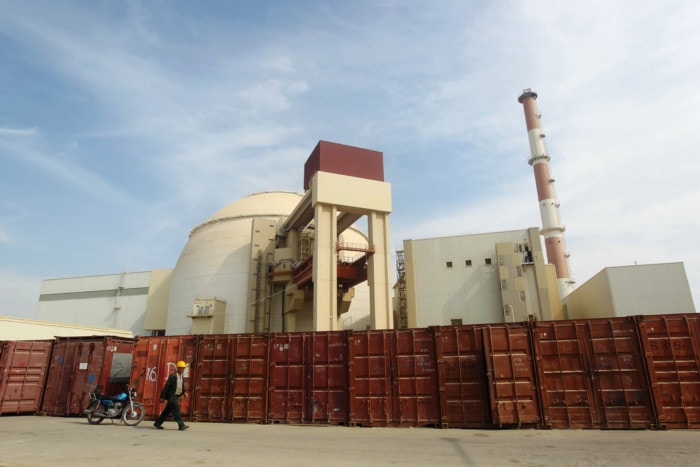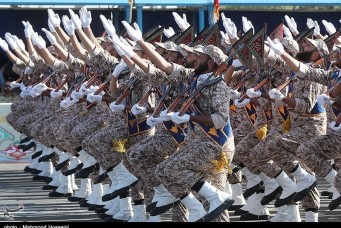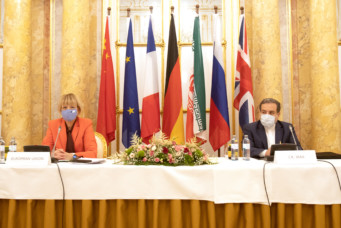In the Zone: The Long and Winding Road to Middle East Disarmament
As the international community grapples with the immediate challenge of Iran’s nuclear program, those in Washington and other capitals should consult Seyed Hossein Mousavian and Emad Kiyaei’s book and perhaps devise a more considered approach to rid the Middle East of the threat of mass destruction that continues to hang over the region.
Ever since the late 1960s, when Israel constituted the first case of nuclear proliferation outside of the five recognized nuclear weapons states (the US, China, France, UK, and the Soviet Union), the threat of weapons of mass destruction has long ranked as one of the leading sources of regional instability. The spread of chemical, biological, and nuclear weapons programs throughout the region, the recurring use of chemical weapons in regional conflicts, most recently in the context of the Syrian civil war, and the threat and actual use of force to counter WMD threats, most notably by the United States and Israel, have become ever present features in the volatile security landscape of the Middle East.
While the threat of regional WMD proliferation has been the subject of much academic scholarship and policy analysis, much less attention has been devoted to the ambitious policy initiative to address it; namely the establishment of a zone free of all weapons of mass destruction in the Middle East (WMDFZME).

A New Approach to Nonproliferation
By Seyed Hossein Mousavian and Emad Kiyaei
Seyed Hossein Mousavian and Emad Kiyaei fill this gap with an important book, A Middle East Free of Weapons of Mass Destruction: A New Approach to Nonproliferation, a timely work that offers a wide-ranging treatment of the zone initiative. Both authors are eminently qualified for this task, bringing a diverse repertoire of experience to the issue of WMD proliferation in the Middle East; Mousavian is a former Iranian diplomat (currently a visiting scholar at Princeton University) who served as Iran’s lead nuclear negotiator, Kiyaei is an Iranian analyst and a director of the Middle East Treaty Organization (METO) a civil society initiative dedicated to advocating for the realization of the zone.
Charting a pathway toward the zone
Much of the book reads like a detailed primer on the multiple WMD proliferation challenges facing the region, as well as the complex technical, diplomatic, and regional security issues that must be addressed in order to establish the zone. The book surveys the background and evolution of the multiple WMD programs that constitute the main sources of proliferation threats in the region: Israel’ acquisition of an undeclared nuclear program that provided the impetus for the first proposals sponsored by Egypt and Iran dating back to the mid-1970s for the establishment of a nuclear weapons free zone in the Middle East; Iraq’s vast WMD complex that was subject to the most coercive disarmament regime in modern history under UN auspices after the 1991 Gulf war; Libya’s fledgling WMD program that was dismantled under international pressure in 2003; Syria’s vast chemical weapons arsenal; and Iran’s long-standing nuclear program that is the focus of current nonproliferation diplomacy.
The authors put forward a number of innovative approaches designed to provide the architecture for the WMDFZME. A regional nuclear fuel bank under international supervision would dissuade countries of the region from developing their own fuel cycle by providing an assured supply of nuclear fuel for their civil nuclear programs. The security framework underpinning the zone would be anchored in a ‘Persian Gulf Cooperative Security Arrangement’ (PGCSA), in essence a sub-regional framework that would only include the Gulf region given the difficulty of establishing a region-wide framework encompassing all countries of the Middle East. Establishment of the zone would come about through a gradual phased process, beginning with general agreement on the fundamental principles of the zone, followed by a series of confidence-building measures (CBMs) to include limitations on conventional weapons, regional cooperation on the peaceful use of nuclear technology, and verification mechanisms for disarmament, and culminating in the sequenced accession of all regional states to the various global nonproliferation treaty frameworks covering biological, chemical and nuclear weapons, in that order.
An Iran-centric approach
Yet, while the book strives toward comprehensiveness in its approach, the one issue that receives the most focus is Iran, and in particular the painstakingly negotiated agreement between Iran and the P5+1 (the permanent members of the UN Security Council and Germany) to cap Iran’s nuclear program, otherwise known by its formal designation as the Joint Comprehensive Plan of Action (JCPOA). The opening chapters offer a detailed examination of the evolution of Iran’s nuclear program, and the negotiating history of the JCPOA focusing in particular on the core bargain of the agreement; the stringent controls imposed on Iran’s nuclear infrastructure to bloc the pathways to its acquisition of nuclear weapons, in exchange for lifting the far-reaching sanctions regime that has exacted a crushing toll on Iran’s economy.
Given this focus, the authors offer what can be described as an Iran-centric approach to the establishment of the zone, arguing that Iran’s experience can serve as a template for a region-wide approach toward this objective. The book correctly observes that the JCPOA “involved some of the most complex diplomatic [nuclear] negotiations ever undertaken”, and that the various control measures covering Iran’s entire nuclear fuel cycle, together with the extensive verification mechanisms—considered among the most stringent in the history of nuclear arms control—can effectively be regionalized to serve as a template for the extensive WMD prohibitions and verification regime at the heart of the zone.
The authors also devote much emphasis on the fatwa, or religious edict, issued by Iran’s supreme leader Ayatollah Khamenei banning possession of all WMDs, which in their view “places a religious obligation on the majority Muslim population of the region and their respective governments to support the realization of the zone and commit to WMD nonproliferation”. While there is a precedent for religious institutions taking a strong position in support of nuclear disarmament, most notably the Catholic church, one is hard pressed to understand how Khamenei’s fatwa can serve as a basis for broader Sunni Muslim support for the zone, let alone provide a foundation for Jewish sanction for such an endeavor that could foster concerted public debate in Israel about its own nuclear posture. Similarly, the security framework proposed by the authors in the form of the PGCSA is very much tailored to Iran’s national security requirements in that it is predicated on the withdrawal of U.S. forces from the Gulf. This has been a long-standing Iranian position that would effectively remove the most direct threat to Iran’s security while undermining the security of the Arab gulf states given their reliance on the U.S. defense umbrella.
Untangling complex linkages:
Much of the challenge involved in establishing the WMDFZME stems from the fact that it is a uniquely novel endeavor. While various other regions have benefited from the creation of nuclear weapons-free zones, never before has there been an attempt to negotiate a regional zone free of all classes of weapons of mass destruction: nuclear, chemical and biological. The broad scope of prohibition, the elaborate treaty framework required to anchor the legal basis for such a zone, and the exacting verification provisions necessary to ensure effective compliance all constitute a set of highly demanding prerequisites without precedent in the realm of arms control or disarmament.
However, the challenge of the zone endeavor stems not just from the need to satisfy these stringent conditions. The issue of WMD disarmament in the Middle East is itself connected through complex linkages to the broader global nonproliferation regime, the constantly shifting matrix of Middle East regional security politics, and the intricacies of the US-Israeli alliance—all of which pose formidable challenges to the zone project.
The book does not adequately untangle these linkages, offering only a cursory treatment on many of the key questions that could have benefited from a more in-depth analysis. For example, the authors do not delve into the motivating factors prompting regional states to expend scarce resources, as well as tolerate much risk, in the pursuit of WMD programs. This applies to their survey of Iran’s nuclear program which they attribute to the need to satisfy the country’s growing energy needs. Notably, the authors avoid any acknowledgement of, or insight into, the military dimensions of the program; a fact that is widely accepted by the international community, including the International Atomic Energy Agency (IAEA). Without understanding the underlying drivers of regional proliferation, it is difficult to understand how to address them through the zone.
No less important is the issue of devising a diplomatic process to negotiate the creation of the zone. This in turn, raises a series of fundamental questions. Should the zone be negotiated at the global level through the United Nations or the periodic review conferences of the NPT, or at the regional level between countries of the Middle East? What of the fact that many states in the region do not even have diplomatic relations, or indeed even accept the legitimacy of their regional rivals? And what should be the role of outside powers that must also undertake commitments of their own in order to keep the zone WMD-free? How the United States in particular should relate to the zone is not addressed, a notable omission given the predominant U.S. role in regional security, and the fact that Washington continues to provide diplomatic cover for Israel’s undeclared nuclear program, a product of a tacit understanding between the two countries dating back to the late 1960s. As a result, the United States has blocked every attempt to launch a negotiating process to establish the zone out of deference to Israel’s objections.
These questions are hardly pedantic. The sensitivity of WMD disarmament has meant that issues of process are as contentious as the substance. How countries talk about the zone, under what terms, and in which particular international or regional forum, are no less important than how WMD programs are dismantled, how this should be verified, and under which legal prohibitions.
How to negotiate the zone is linked to a more fundamental issue of the relationship between arms control and regional security. This is a conceptual conundrum that revolves around the question of whether the resolution of the region’s conflicts should constitute a prerequisite for establishing a WMDFZME in order to foster a more benign regional security environment, or whether the zone should come into being separately from the settlement of these conflicts. This question has long stood as the principal source of contention between Egypt and Israel over the broad approach that should govern regional arms control. Israel has consistently argued that achieving meaningful progress on the zone must be conditioned on resolution of the Arab-Israeli conflict, regional acceptance of Israel’s right to exist, and a process of confidence building through security cooperation between Israel and the Arab states. Observers have termed this ‘the long corridor’ approach; only at the end of it can Israel muster the confidence to engage in meaningful arms control. As the initiator of the zone proposal and is most forceful advocate, Egypt has argued that the zone can mitigate regional conflict at lower levels of armament, and therefore should not be held hostage to the noble but arduous task of achieving peace in the Middle East. Failure to reconcile these fundamentally divergent approaches to arms control has constituted one of the primary obstacles to advancing the cause of Middle East disarmament over the past four decades.
On this question of the relationship between arms control and security, the authors’ analysis offers contradictory assessments. They state clearly that “any progress on the Palestinian-Israeli peace process will inevitably provide positive momentum toward the zone, but should not be held hostage to it”. Furthermore, the authors correctly observe how the JCPOA itself offers a fascinating case study of how the issues of arms control and regional security can be compartmentalized. The agreement was the result of a decades-long negotiating process between the United States (as the principal actor in the P5+1 group) and Iran—two countries without a formal diplomatic relationship, and a legacy of mutual animosity with few parallels in contemporary international politics. Yet, U.S. and Iranian negotiators managed to reach a tacit understanding to deliberately insulate the nuclear file from the issue of Iran’s interventionism in the region’s conflicts. The thorny challenges of Iran’s threats to regional security were thus not allowed to intrude on the arms control track that produced the JCPOA.
This compartmentalization, however, produced a regional backlash from both the Arab Gulf states and Israel as they faced the growing threat of Iran’s regional adventurism, which in their view was magnified manyfold once Iran was free of the constraint of sanctions. The sustained regional pushback against the JCPOA, a factor that at least in part prompted the Trump Administration’s withdrawal from the agreement in May 2018, shows that the issues of regional security and arms control are not so easily decoupled. This linkage also comes to the fore in the authors’ proposal for a PGCSA as the basis for a sub-regional zone in the Gulf. That the proposal is predicated on Iran’s call to ‘regionalize’ the security of the Gulf region through the removal of America’s military presence, highlights the degree to which Iran’s arms control approach is tailored to its own particular conception of regional security.
A blueprint for a comprehensive approach:
The decision of the Trump Administration to withdraw the United States from the JCPOA, has prompted Iran to gradually walk back many of the restrictions on its nuclear program that it had accepted under the terms of the agreement. Most significant in this regard is Iran’s decision to reconstitute its enrichment program, including increasing its stock of enriched uranium, resuming research on the design of new centrifuges, and its threat to curtail access for IAEA inspectors to its nuclear facilities, a step that would undermine the verification mechanism designed to ensure Iran’s compliance with its commitments under the agreement. The cumulative effect of these measures is to place Iran on a trajectory toward achieving a breakout capacity— the ability to rapidly constitute a military nuclear capability—which is precisely the outcome that the JCPOA was intended to forestall.
The Biden Administration recognizes the urgency of this threat and has clearly enunciated that reviving the JCPOA will be among its foremost foreign policy priorities. Resuming the negotiating process with Iran, dismantling the multiple layers of sanctions against Iran’s economy reinstituted since Trump’s decision to withdraw from the agreement, negotiating a follow-on agreement that would cover Iran’s missile program, and doing all this while managing the domestic politics in both Washington and Tehran will require deft diplomatic handling.
Yet, the JCPOA, impressive as it is in terms of its technical sophistication, represents a piecemeal solution to the Middle East’s proliferation problem, far short of the type of comprehensive approach embodied in the WMDFZME proposal. This ad-hoc approach has long characterized the U.S. strategy of addressing WMD threats in the region whether through the use of military force as was the case with Iraq and Syria, or coercion as applied to Libya, or a mix of diplomacy and economic pressure vis-à-vis Iran. Unfortunately, this approach has proven to be inadequate in halting the proliferation trend in the region. The threat posed by Iran’s nuclear program is only the latest iteration of this trend; today Iran, tomorrow some other country will pose a similar challenge.
The absence of a comprehensive approach for a region-wide disarmament framework which is at the heart of the zone proposal has only abetted this trend. The challenges facing the establishment of a WMDFZME are no doubt formidable. Yet, Mousavian and Kiyaei have provided us with a valuable blueprint for such an endeavor. As the international community grapples with the immediate challenge of Iran’s nuclear program, those in Washington and other capitals charged with this task would be well-advised to consult this important book and perhaps devise a more considered approach to rid the Middle East of the threat of mass destruction that continues to hang over the region.
Karim Haggag is co-managing editor of the Cairo Review of Global Affairs and director of Masters of Global Affairs. He was previously director of the Prince Alwaleed Center for American Studies and Research at the American University in Cairo. He joined AUC as professor of practice in the Department of Public Policy and Administration and the Middle East Studies Center in July 2017, bringing over twenty-five years of experience in Egypt’s diplomatic service. Throughout his career, he served in numerous positions including director of the Egyptian Press and Information Office in Washington D.C. from 2007–11 and in the Office of the Presidency in Cairo from 2002– 2007. Haggag was also a visiting professor with the Near East and South Asia Center for Strategic Studies at the National Defense University in Washington D.C. from 2011 to 2013.
Read MoreSubscribe to Our Newsletter






